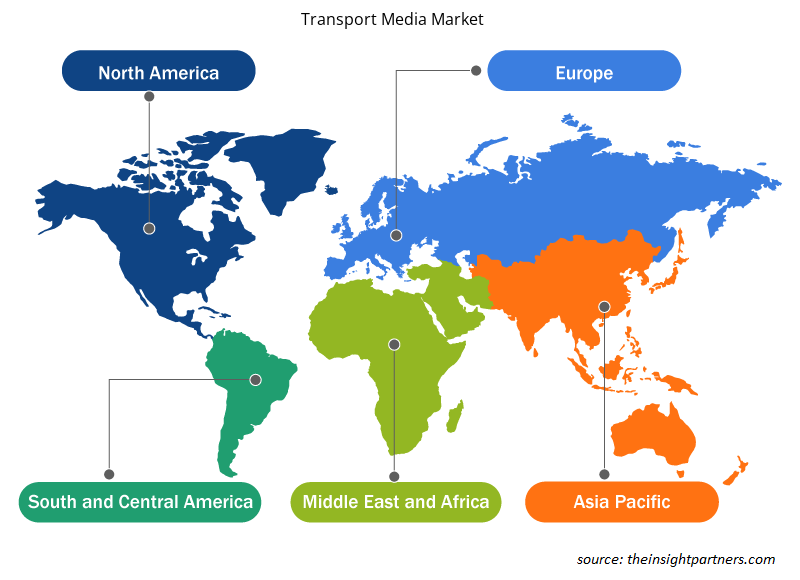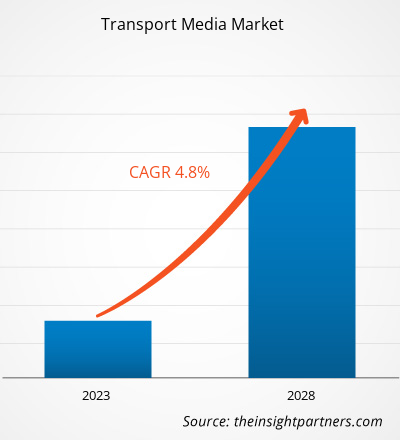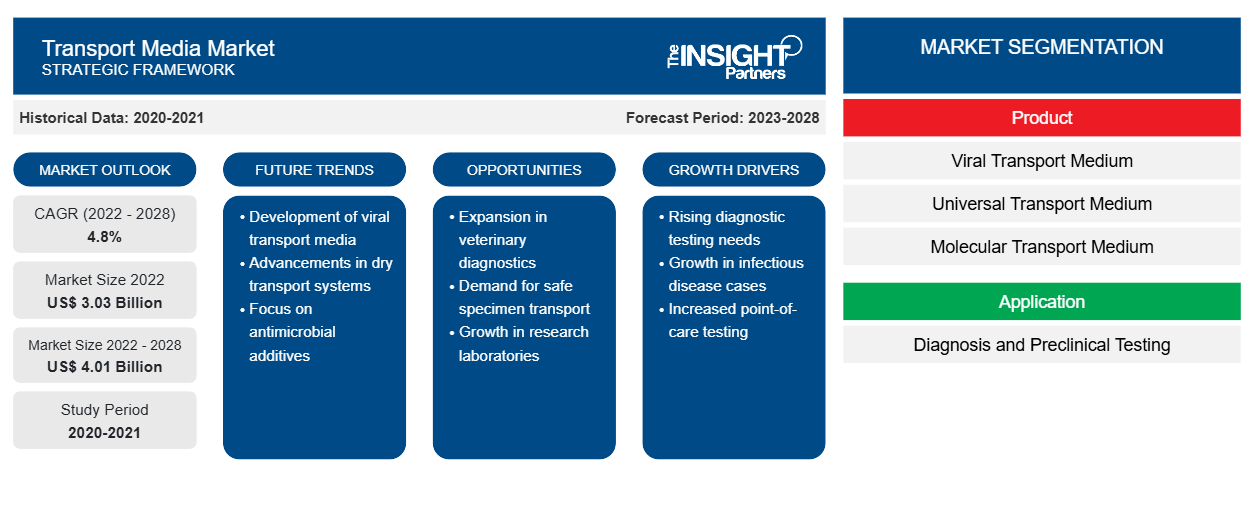Si prevede che il mercato dei media di trasporto crescerà da 3.030,21 milioni di dollari nel 2022 a 4.014,88 milioni di dollari entro il 2028; si prevede che registrerà un CAGR del 4,8% dal 2021 al 2028.CAGR of 4.8% from 2021 to 2028.
Il mezzo di trasporto microbico è essenzialmente un tampone contenente nutrienti (esclusi i fattori di crescita) come carboidrati e peptoni, ed è progettato per mantenere la vitalità batterica durante il trasporto senza crescita batterica. Lo scopo principale dell'utilizzo di un mezzo di trasporto è quello di consegnare il campione il più vicino possibile al suo stato originale.peptones, and is designed to maintain bacterial viability during transport without bacterial growth. The main purpose of using a transport medium is to deliver the sample as close to its original state as possible.
La crescita del mercato dei mezzi di trasporto è attribuita all'aumento della domanda dovuto al crescente numero di iniziative adottate dal governo per aumentare il tasso di adozione dei kit di test. Tuttavia, problemi clinici e tecnici correlati alla raccolta dei tamponi e ai mezzi di trasporto limitano la crescita del mercato.
Il mercato dei media di trasporto è segmentato in base a prodotto, applicazione, utente finale e area geografica. In base all'area geografica, il mercato è ampiamente segmentato in Nord America, Europa, Asia Pacifico, Medio Oriente e Africa e Sud e Centro America. Il rapporto di mercato offre approfondimenti e analisi approfondite del mercato, sottolineando parametri quali dimensioni del mercato, tendenze, progressi tecnologici e dinamiche di mercato, nonché l'analisi del panorama competitivo dei principali attori del mercato a livello mondiale. Inoltre, il rapporto include l'impatto della pandemia di COVID-19 sul mercato dei media di trasporto in tutte le regioni.
Personalizza questo report in base alle tue esigenze
Riceverai la personalizzazione gratuita di qualsiasi report, comprese parti di questo report, o analisi a livello nazionale, pacchetto dati Excel, oltre a usufruire di grandi offerte e sconti per start-up e università
-
Scopri le principali tendenze di mercato in questo rapporto.Questo campione GRATUITO includerà analisi di dati che spaziano dalle tendenze di mercato alle stime e alle previsioni.
Approfondimenti di mercato
L'aumento della domanda dovuto alla pandemia di COVID-19 stimola la crescita del mercato dei media sui trasporti
La domanda di terreni di trasporto è aumentata con l'aumento dei test per il COVID-19. Affinché i test siano accurati e affidabili, la qualità del campione e le condizioni di trasporto e conservazione del campione prima dell'elaborazione sono fondamentali. Per questo, l'uso di un terreno di trasporto virale è diventato comune e la sua domanda è aumentata esponenzialmente. I terreni di trasporto virale più comunemente utilizzati erano le provette di plastica con tappo a vite contenenti proteine tamponate e antibiotici per prevenire la crescita di contaminanti, come batteri e funghi. Molte aziende hanno avviato la produzione in serie di un terreno di trasporto virale per il trasporto di campioni di tamponi nasofaringei e orofaringei ai laboratori diagnostici per la conferma. Inoltre, molte università e organizzazioni di ricerca hanno supportato il processo di produzione riducendo i progetti di ricerca per prevenire focolai sul posto di lavoro. Hanno spostato le loro operazioni sulla produzione personalizzata di terreni di trasporto virale per produrre kit di test per il COVID-19. Ad esempio, l'Ohio State University Wexner Medical Center ha collaborato con i suoi laboratori e studenti correlati per produrre 254.791 provette per test di terreni di trasporto virale per una rapida distribuzione in tutto l'Ohio.nasopharyngeal and oropharyngeal swab specimens to diagnostic laboratories for confirmation. Further, many universities and research organizations supported the production process by reducing research projects to prevent workplace outbreaks. They shifted their operations to custom production of viral transport medium to produce COVID-19 test kits. For instance, the Ohio State University Wexner Medical Center collaborated with its related laboratories and students to produced 254,791 viral transport media testing tubes for prompt distribution throughout Ohio.
Con l'aspettativa di ulteriori ondate della pandemia di COVID-19 a livello regionale, sono necessari test COVID-19 robusti e su larga scala per prevenire impatti negativi, come la perdita di vite umane. Si prevede che ciò guiderà il mercato dei media di trasporto, in particolare dei media di trasporto virali, nei prossimi anni. Inoltre, oltre al SARS-CoV-2, stanno diventando comuni vari altri focolai di malattie infettive, che richiedono test rapidi e un lavoro di ricerca che dovrebbe anche aiutare la crescita del mercato.
Tuttavia, la pandemia di COVID-19 ha gravemente interrotto le forniture mondiali di terreni di trasporto virali (VTM) a causa della domanda diffusa di test di trascrizione inversa-PCR (RT-PCR) per la sindrome respiratoria acuta grave coronavirus 2 (SARS-CoV-2). In risposta a questa carenza in corso, gli operatori di mercato che operano nella regione hanno iniziato la produzione interna di VTM a supporto dei test diagnostici nella rete ospedaliera. Ad esempio: nell'ottobre 2020, COPAN Diagnostics Inc. ha annunciato che 5 milioni di UTM (Universal Transport Medium) sono stati spediti dal nuovo stabilimento di produzione dell'azienda a Carlsbad, in California, per svolgere un ruolo fondamentale nella lotta contro il virus mortale.VTM) due to widespread demand for severe acute respiratory syndrome coronavirus 2 (SARS-CoV-2) reverse transcription-PCR (RT-PCR) testing. In response to this ongoing shortage, market players operating in the region began the production of VTM in-house in support of diagnostic testing in the hospital network. For Instance: In October 2020, COPAN Diagnostics Inc. announced that 5 million UTM (Universal Transport Medium) was shipped from the company's new manufacturing facility in Carlsbad, California, to play an integral part in the battle against the deadly virus.
Approfondimenti basati sui prodotti
In base al prodotto, il mercato dei media di trasporto è segmentato in media di trasporto virale, media di trasporto universale, media di trasporto molecolare e altri. Nel 2022, il segmento dei media di trasporto virale deteneva la quota maggiore del mercato. Tuttavia, si prevede che il segmento dei media di trasporto molecolare registrerà il CAGR più elevato del 5,2% durante il periodo di previsione.CAGR of 5.2% during the forecast period.
Approfondimenti basati sulle applicazioni
In base all'applicazione, il mercato dei mezzi di trasporto è diviso in diagnosi e test preclinici. Il segmento della diagnosi ha detenuto la quota di mercato più grande nel 2022. Inoltre, si prevede che lo stesso segmento registrerà il CAGR più elevato durante il periodo di previsione.preclinical testing. The diagnosis segment held the largest market share in 2022. Moreover, the same segment is anticipated to register the highest CAGR during the forecast period.
Informazioni basate sull'utente finale
In base all'utente finale, il mercato dei mezzi di trasporto è segmentato in ospedali e cliniche, laboratori di microbiologia, laboratori di diagnostica e altri. Tuttavia, si prevede che il segmento dei laboratori di diagnostica registrerà il CAGR più elevato durante il periodo di previsione.CAGR during the forecast period.
Gli operatori del mercato dei media di trasporto si concentrano sull'adozione di strategie organiche, come il lancio e l'espansione dei prodotti, per ampliare la propria presenza e il proprio portafoglio prodotti a livello globale e soddisfare la crescente domanda.
Approfondimenti regionali sul mercato dei media di trasporto
Le tendenze regionali e i fattori che influenzano il Transport Media Market durante il periodo di previsione sono stati ampiamente spiegati dagli analisti di Insight Partners. Questa sezione discute anche i segmenti e la geografia del Transport Media Market in Nord America, Europa, Asia Pacifico, Medio Oriente e Africa, e Sud e Centro America.

- Ottieni i dati specifici regionali per il mercato dei media di trasporto
Ambito del rapporto sul mercato dei media di trasporto
| Attributo del report | Dettagli |
|---|---|
| Dimensioni del mercato nel 2022 | 3,03 miliardi di dollari USA |
| Dimensioni del mercato entro il 2028 | 4,01 miliardi di dollari USA |
| CAGR globale (2022 - 2028) | 4,8% |
| Dati storici | 2020-2021 |
| Periodo di previsione | 2023-2028 |
| Segmenti coperti |
Per Prodotto
|
| Regioni e Paesi coperti |
America del Nord
|
| Leader di mercato e profili aziendali chiave |
|
Densità degli attori del mercato dei media di trasporto: comprendere il suo impatto sulle dinamiche aziendali
Il mercato dei media di trasporto sta crescendo rapidamente, spinto dalla crescente domanda degli utenti finali dovuta a fattori quali l'evoluzione delle preferenze dei consumatori, i progressi tecnologici e una maggiore consapevolezza dei vantaggi del prodotto. Con l'aumento della domanda, le aziende stanno ampliando le loro offerte, innovando per soddisfare le esigenze dei consumatori e capitalizzando sulle tendenze emergenti, il che alimenta ulteriormente la crescita del mercato.
La densità degli operatori di mercato si riferisce alla distribuzione di aziende o società che operano in un particolare mercato o settore. Indica quanti concorrenti (operatori di mercato) sono presenti in un dato spazio di mercato in relazione alle sue dimensioni o al valore di mercato totale.
Le principali aziende che operano nel mercato dei media di trasporto sono:
- THERMO FISHER SCIENTIFIC INC.
- BD
- Diagnostica EKF
- Prodotti medici puritani
- Laboratori HiMedia
Disclaimer : le aziende elencate sopra non sono classificate secondo un ordine particolare.

- Ottieni una panoramica dei principali attori del mercato dei media di trasporto
Per Geografia
In base all'area geografica, il mercato dei media di trasporto è segmentato in Nord America (Stati Uniti, Canada e Messico), Europa (Regno Unito, Germania, Francia, Italia, Spagna e resto d'Europa), Asia Pacifico (Cina, Giappone, India, Australia, Corea del Sud e resto dell'Asia Pacifico), Medio Oriente e Africa (Emirati Arabi Uniti, Arabia Saudita, Sudafrica e resto del Medio Oriente e dell'Africa) e Sud e Centro America (Brasile, Argentina e resto del Sud e Centro America).
Profili aziendali
- Thermo Fisher Scientific Inc.
- BD
- Diagnostica EKF
- Prodotti medici puritani
- Laboratori HiMedia
- Trinità Biotech
- VIRCELLELLA SL
- Cavi e attrezzature mediche
- COPAN Diagnostics Inc.
- Tecnologia
- Analisi storica (2 anni), anno base, previsione (7 anni) con CAGR
- Analisi PEST e SWOT
- Valore/volume delle dimensioni del mercato - Globale, Regionale, Nazionale
- Industria e panorama competitivo
- Set di dati Excel
Report recenti
Rapporti correlati
Testimonianze
Motivo dell'acquisto
- Processo decisionale informato
- Comprensione delle dinamiche di mercato
- Analisi competitiva
- Analisi dei clienti
- Previsioni di mercato
- Mitigazione del rischio
- Pianificazione strategica
- Giustificazione degli investimenti
- Identificazione dei mercati emergenti
- Miglioramento delle strategie di marketing
- Aumento dell'efficienza operativa
- Allineamento alle tendenze normative























 Ottieni un campione gratuito per - Mercato dei media di trasporto
Ottieni un campione gratuito per - Mercato dei media di trasporto